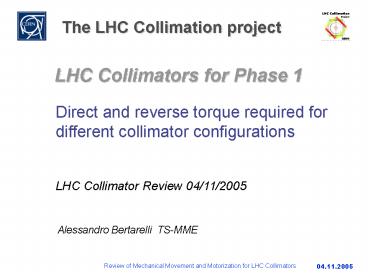The LHC Collimation project - PowerPoint PPT Presentation
1 / 14
Title:
The LHC Collimation project
Description:
Direct and reverse torque required for different collimator configurations ... Required torque for direct drive: Back-driving torque available at motor shaft: ... – PowerPoint PPT presentation
Number of Views:43
Avg rating:3.0/5.0
Title: The LHC Collimation project
1
The LHC Collimation project
- LHC Collimators for Phase 1
Direct and reverse torque required for different
collimator configurations
LHC Collimator Review 04/11/2005
Alessandro Bertarelli TS-MME
2
Torque calculations
- Outline
- Actuation system layout
- Assumptions and hypotheses
- Some formulas
- Minimum motor torque required for direct motion
(pull-in torque) - Maximum admissible residual torque for back-drive
motion (detent torque) - Outlook and risks
3
Actuation system layout
Direct mode
Friction Torque C (bearings, rotating components,
etc.)
Motor Pull-in Torque T
Resistive force F (weight component, springs,
vacuum, friction )
4
Actuation system layout
Reverse mode (auto-retraction)
Friction Torque C (bearings, rotating components,
etc.)
Motor Detent Torque M
Active resulting force F
5
Design data and assumptions
- Motor specifications
- 400 steps/rev hybrid stepping motor
- 3.5 Nm Nominal Torque
- 80 mNm maximum Detent Torque
- Re-circulating roller screw
- Diamter (d) 12mm lead (p) 2mm useful stroke
(c) 35 mm efficiency (h) 0.67 - Springs (two versions)
- Wire Ø5 K5.15 N/mm Preload75mm
- Wire Ø6.3 K12.98 N/mm Preload55mm
- Effects taken into account
- Spring loads
- Weight of jaw and table assembly
- Effect of bellow (both elastic and vacuum)
- Ball bearing friction
- RF contacts friction
- Table friction
- No safety margins!!
6
Torque calculations
- Some basic formulas
- Practical direct efficiency
- Reverse screw efficiency
- Required torque for direct drive
- Back-driving torque available at motor shaft
7
Minimum Motor Torque (Pull-in)
Orientation b0 C-C jaw
Spring Ø6.3
Pull-in Torque(Nmm)
Spring Ø5
Jaw position(mm)
Full in
Full out
centerline
8
Minimum Motor Torque (Pull-in)
Spring Ø6.3
Pull-in Torque(Nmm)
Orientation b90 Metal jaw
Spring Ø5
Jaw position(mm)
Full in
Full out
centerline
9
Return stroke (quasi-static) versus Motor Detent
Torque
Full in
Beam axis
Spring Ø5
Jaw position(mm)
Spring Ø6.3
Orientation b0 (C-C jaw)
Full out
10
Return stroke (quasi-static) versus Motor Detent
Torque
Full in
Spring Ø5
Spring Ø6.3
Jaw position(mm)
Orientation b-90 (Metal jaw)
Full out
11
Maximum Return stroke (dynamic) versus time
Orientation b0 (C-C jaw)
Operating position
Jaw position(mm)
Spring Ø6.3 Detent Torque 115 Nmm
Spring Ø5 Detent Torque 54 Nmm
Full out
12
Maximum Return stroke (dynamic) versus time
Orientation b-90 (Metal jaw)
Operating position
Jaw position(mm)
Spring Ø6.3 Detent Torque 74 Nmm
Spring Ø5 Detent Torque 12 Nmm
Full out
13
Torque calculations
- Outlook and risks (1)
- Maximum required torque (Pull-in) is 1 Nm for
the worst configuration (metal jaw vertical
configuration strong spring) - In a quasi-static motion, full back-driving in
the worst case is ensured for any jaw opening
only if motor detent torque is smaller than 40
Nmm (or mNm) - If a maximum detent torque of 80 Nmm is assumed,
quasi-static self-retraction is not possible in
the worst configuration for strokes smaller than
14mm - If the jaw is assumed to be in the full-close
position (30 mm stroke), full self-retraction is
obtained up to 80 Nmm detent torque
14
Torque calculations
- Outlook and risks (2)
- No specific safety margins are used for these
calculations! - Friction prediction is very difficult and not
necessarily conservative! - Though big care has been paid in its
qualification, the main concern is given by
possible degradation of the roller screw
efficiency (no auto-retraction is possible if the
efficiency is smaller than 0.5)! - An adequate safety margin should be taken for the
minimum pull-in torque and the maximum detent
torque (at least 1.5, plus an additional marging
from Failure Mode Effect Analysis).































